When purchasing an American flag, there are a lot of things to consider. What size you need, what company to choose, how the flag is constructed, how it’s going to be displayed, how much you’re willing to spend, and materials. Is there a difference, is one material better than the other, will one last longer than the other, or does the material even matter?
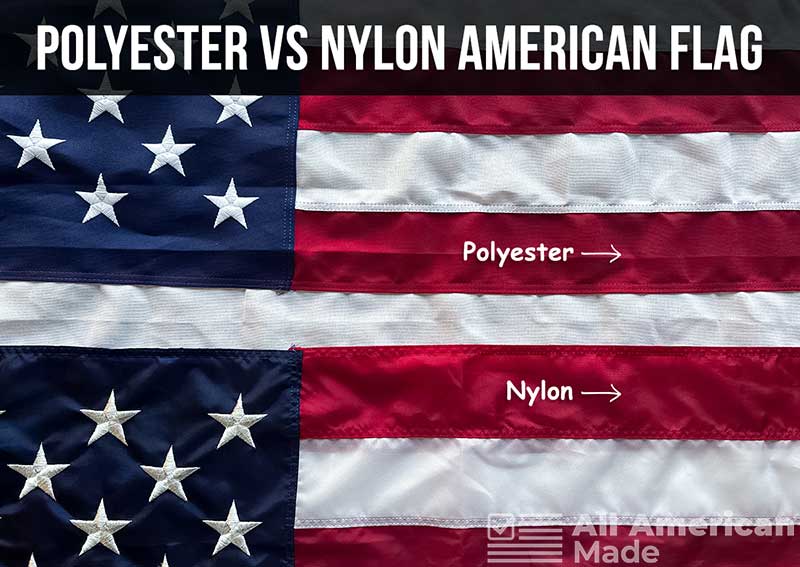
Yes, the material does matter, and it depends on what you are using the flag for, where it is going to be mounted, and even where you live can be a factor. Here we will discuss in detail the different materials a flag can be made from, along with where and what is the best material for displaying your flag.
The biggest difference between nylon and polyester flags is that nylon flags are lighter, allowing them to fly nicely in even a light breeze. Polyester flags are generally stronger and last longer.
That’s a very brief explanation, though, and there are many more factors to consider, which we’ll talk about below.
What Are Nylon Flags Best For?
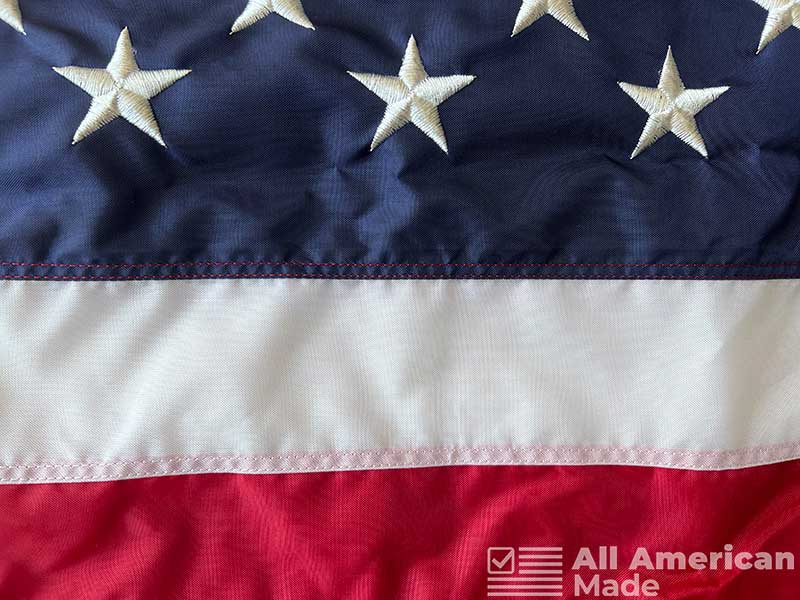
Nylon fabric was invented when Dupont scientists realized they could create fibers from polymers in the 1930s. Early uses of this new material included toothbrush bristles and women’s stockings. Later on, as the product was developed more, the military started using nylon material for parachutes because of its strength and how lightweight it was. Soon nylon was being used for many other purposes such as carpets, car parts like seatbelts, guitar strings, tents, rope, sutures (medical stitches), and of course, flags.
The Strengths of Nylon Flags Are:
Lightweight: Nylon flags are lighter than any other material. They will unfurl and flap in the lightest of breezes, making them a great outdoor flag in areas that don’t get much wind.
Vibrant colors: When nylon fabric or threads are dyed, they naturally cause the colors to “pop.” Flags made of nylon have brighter, more vibrant colors than other fabrics. When polyester and cotton flags are compared to the colors of nylon flags, they tend to look dull and not as bright.
Colorfast: Nylon fabric accepts dye easily and holds onto the colors longer than other materials. Nylon also has a reflective sheen to it that many people desire. It makes them look great in sunlight.
Resistant to mold and mildew: Unlike cotton, silk, and other natural materials, nylon doesn’t get moldy or mildew very often. Mold needs something organic to feed on or it won’t grow. Nylon, being a completely synthetic fiber, has nothing for mold and mildew spores to feed on, so clean flags that don’t have any dirt or soil on them won’t mold. The same goes for insects. Since there is nothing for them to eat, nylon flags won’t get nibbled on the way cotton, wool, or other natural fabrics do.
Strong: Fabric made of nylon is very strong. The material is rip-resistant and very difficult to tear. It’s one of the reasons parachutes and paracords are made from this material. Even in high winds, nylon flags hold up well and don’t fray easily. Nylon is also very abrasion resistant, meaning your flag should last a long time with proper care.
Fast drying: Natural fibers readily absorb and hold onto moisture. This makes cotton flags an unsatisfactory choice for outdoor displays. Nylon is naturally water resistant. While this material will absorb some water, it doesn’t take on as much as natural materials. Because of this nylon is a fast-drying material, making it a good choice for outdoor uses where your flag could experience inclement weather.
Resistant to weather: Anything that is left outside in the sun, especially during the hot summer months when the sun is at its most intense, will begin to fade after a time. Nylon is UV resistant, so it fades slower than some other materials.
Washable: Nylon is an easily cleaned material. You might be able to simply rinse it off with a hose or hand wash your nylon flag. If that doesn’t work, or you don’t have the time to hand clean it, you can throw your nylon flag—by itself—into your washing machine. Just be sure to use cold water and no fabric softeners (they coat fabrics in a waxy substance) on the delicate cycle. Then you hang it up to dry, don’t put your flag in the dryer. Some dryers will get too hot and could cause permanent damage to your nylon flag, so keep it away from the dryer. Your nylon flag will dry in no time by hanging it up.
Stain resistant: Compared to natural materials, nylon is more stain resistant.
Long lasting: Because nylon is made of synthetic materials, it lasts longer than natural threads. Cotton, linen, silk, and wool can be beset by insects; they degrade and decompose faster and are not as weather resistant as nylon. While the elements can take a toll on a nylon flag, it’s built for outdoor weather and will last longer than natural materials.
Inexpensive: Nylon is a cheaper material than cotton or polyester. Cotton has to be grown, and the cost is based on several factors, whereas nylon is manufactured from plastics. The raw materials for nylon are more readily available and not dependent on things like the weather. A single cotton crop can be destroyed by drought or insects and will adversely affect the price.
Lower carbon footprint: Nylon can be recycled and lasts longer than natural fiber counterparts. Because nylon flags don’t have to be replaced as quickly as natural material options, they ultimately end up leaving behind less of a carbon footprint than cotton flags.
Best Uses For Nylon Flags
Nylon flags are the best all-purpose flags. They will fly when there is only a slight breeze, will last a long time, and they stand up well to most weather conditions. Nylon flags are also lightweight, even when they get wet, so if you have a house-mounted flagpole, a nylon flag is the best choice. Cotton or polyester flags can get heavy and could break the pole or the mount on side-mounted flagpoles.
Nylon flags are the most popular choice for homeowners who want to display their patriotic colors. Unless you live in an area that constantly gets very high winds or a lot of bad weather, then a nylon flag will probably be the best choice for you.
If you are looking for a flag that has the brightest colors and shines like new money on sunny days, then nylon is the material you are looking for.
Negatives to Nylon Flags
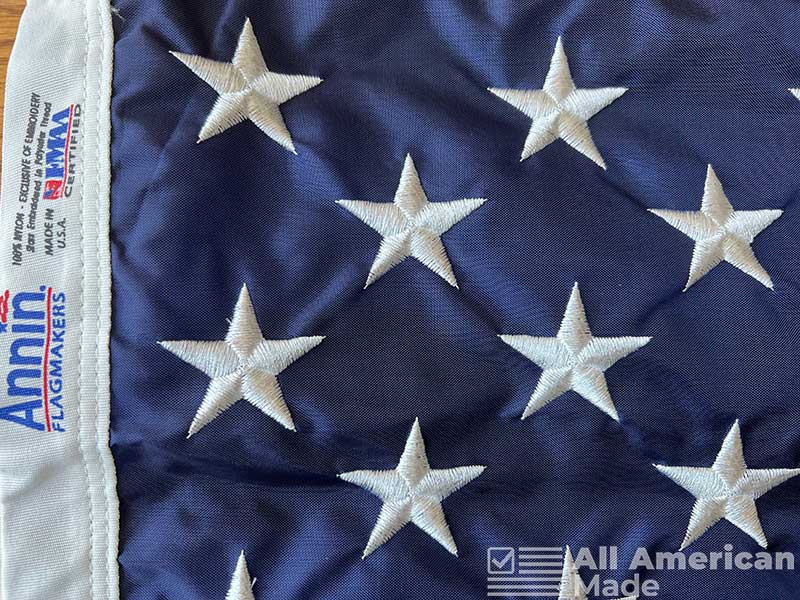
There are not many cons to nylon flags as they are a great all-around material that looks great and flies well for household applications. The biggest problem with nylon flags is they are not as resilient as polyester flags. If you only fly your flag during clear days and take care of it, a nylon flag will still last a long time before you have to replace it, but polyester flags on the whole will last longer.
Another con for nylon flags is the problems they create when it’s time to retire the flag. They take decades to break down when buried and produce toxic smoke when burned. When an American flag becomes torn or frayed, it will need to be retired in a dignified way according to the US Flag Code. The American flag can be buried or burned as a way of retiring it if it’s shown proper respect. Before you hold a burning ceremony, make sure you hold the proper ceremony and check local burn ordinances because nylon materials can release toxic fumes when ignited. If neither of these options appeals to you, you can always reach out to Boy or Girl Scout organizations, your local chapter of VFA (Veterans of Foreign Affairs), or the American Legion. These places will often take your old flag and dispose of it properly for you.
What Are Polyester Flags Best For?
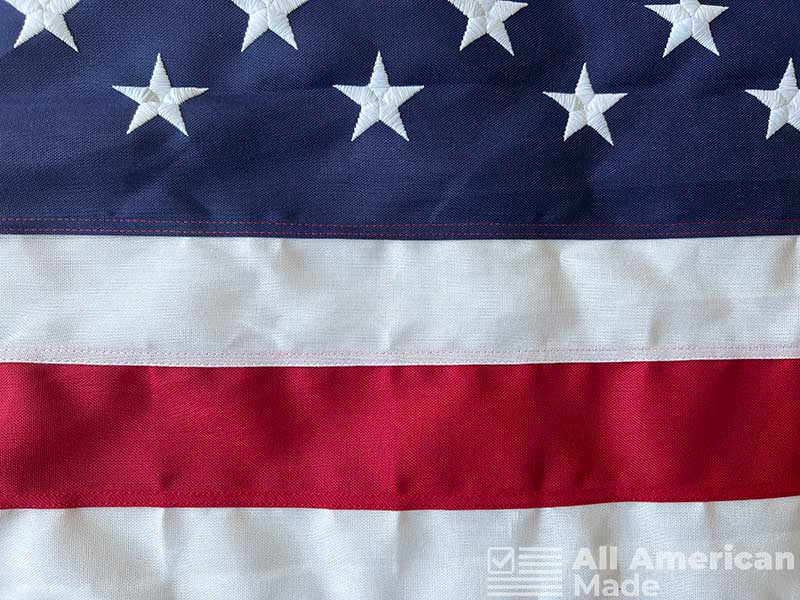
Polyester is another fabric created by plastic polymers. It was also created in Dupont labs, but at a time when the company wanted to focus more on nylon which was quickly gaining popularity. In 1941 British scientists created the first polyester fiber, and soon after, clothing was beginning to be made from this new, strong, synthetic fiber and then flags.
Strengths of Polyester Flags Include:
Wrinkle resistance: Polyester doesn’t wrinkle very easily, so as long as your flag is stored properly, you won’t have to worry much about displaying a wrinkled, unkempt-looking American flag.
More abrasive resistant: Polyester is even more abrasive resistant than nylon, which tends to pill (when the fibers roll up into a tiny ball on the fabric) faster.
Easily cleaned: Flags made from polyester materials can be cleaned the same way nylon flags are washed. You can either hand wash it with a mild detergent in cold water or throw it into your washer in cold water on a gentle or delicate cycle.
Stain resistant: Being a man-made material, polyester is naturally stain resistant, though it does tend to hold onto oily and greasy stains. For normal outdoor flag flying, your polyester flag shouldn’t come across those types of stains.
Weather resistant: Polyester flags are even more weather resistant than nylon flags. They boast better fade resistance and hold up better to storms and inclement weather. Polyester flags are better off in areas that get heavy, frequent storms or along the coast.
Mold and mildew resistance: Just as in nylon, polyester has nothing for organisms to eat, so as long as the flag remains clean, you shouldn’t have to worry about it getting covered in mildew and mold.
Most durable: This is where polyester flags really shine. They are the most durable flags on the market. You will probably pay more for them, but a high-quality, thick polyester flag stands up to the elements better than any other material made so far.
Larger flag: Due to the strength and durability of polyester, this material is the go-to choice for the largest commercial flags. Have you ever been driving on the highway and spotted a massive flagpole with a huge flag waving in the wind, high above the treeline? That flag was made of polyester because it has the strength to stand up to the demands of such a large flag.
Won’t shrink: Since the polyester fabric is made of plastic polymers, it won’t shrink like cotton and wool.
Fade-resistant: Flags manufactured of polyester fabric hold their colors even better than nylon flags. While all fabrics will fade over time when left in the sun and weather, polyester is the king of longevity.
Best Uses For Polyester Flags
Both polyester and nylon flags are approved for outdoor use, but for the harshest environments, largest applications, and longest life of your flag, a polyester American flag is the best choice. Polyester stands up better to abrasion and high winds, so if you live somewhere that constantly gets high winds, you should probably go with a polyester flag.
Polyester flags are better suited for coastal applications as well. They can withstand the abrasive salt air and the strong winds that typically assail coastal areas.
Negatives For Polyester Flags
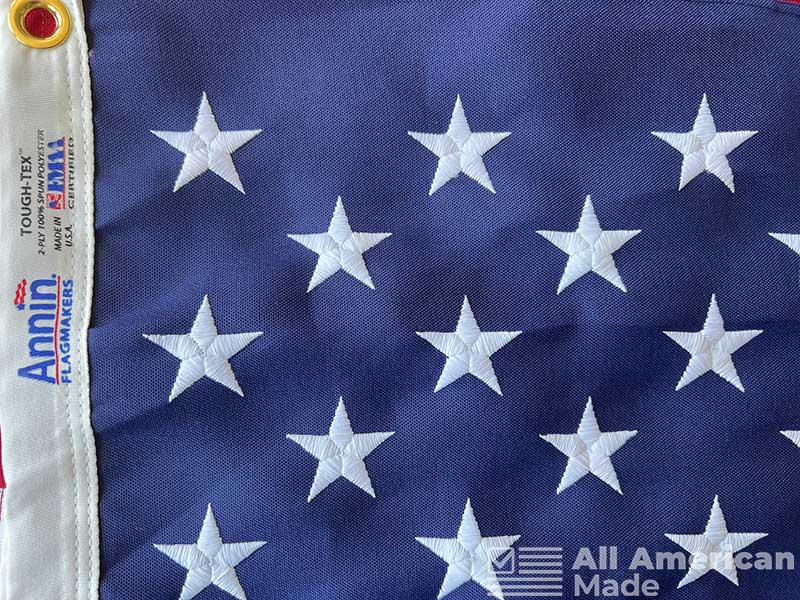
Polyester flags are typically heavier than nylon flags, so they will need more robust flagpoles to keep them flying. A polyester flag mounted on the side of a house or post could be too heavy for that type of mounting, especially if the pole is wood or the flag gets wet. Because of their added weight, it takes a stronger breeze to fly a polyester flag. If your area doesn’t often get strong wind gusts, you may end up seeing your polyester flag drooping more often than not.
The texture of polyester flags is rougher than nylon. Flags manufactured from nylon have a smooth, almost silky feel to them, but polyester is often a rougher texture. This texture also lends to the next con of polyester flags, and that’s a dull color. While nylon flags have an iridescent quality with vibrant colors, polyester flags are more matte or flat looking. But as we’ve said, polyester will hold the colors longer than nylon.
Good quality polyester flags are often made of a two-ply thread, meaning that two threats are twisted together to make one, and then it’s woven together. This makes the flags stronger, but also heavier, and most times more expensive. Polyester flags are often more expensive than nylon flags because of this, but again the trade-off is longevity.
Being a man-made, plastic material, polyester takes a long time to break down compared to cotton and nylon. Polyester can take up to 200 years to completely decompose, so it’s better to dispose of a polyester flag by holding a respectful burning ceremony, but that causes problems as well. Polyester fabrics melt before they burn, and when the flames do catch, they can produce toxic fumes like nylon.
Popular Related Article: American Flags Made in the USA (Top Brands)
Early Flags Were Made of Natural Materials
During the early years of this budding new country, flags were made of natural materials like cotton, wool, linen, and occasionally silk, depending on what was available. Cotton was the most readily available material because it was grown in America.
Synthetic fabrics like nylon and polyester weren’t invented until the 1930s and 1940s, so until then, flags were made of natural materials which tended to fade, shrink, and fray much sooner than flags made today.
Some flags today are still made with cotton, especially flags meant for indoor displays only or ceremonial flags draped over coffins. Many flag purists prefer cotton flags because of their historical significance.
The problems with cotton flags come when they are displayed outdoors. Since they are made from natural materials, they don’t last very long when exposed to sunlight, rain, wind, and extreme heat, and cold. Cotton tends to shrink after it gets wet and will fade rather quickly. Since it’s a natural material, cotton flags left outdoors tend to get mildewy or moldy rather quickly.
Are Cotton Flags Used Anymore?
Cotton flags are still used, and most flag companies offer a few purchase options when it comes to all-natural cotton flags. Cotton flags are not suited for outdoor use because they don’t last long, can bleed colors, and shrink. Flags made of cotton are often used as indoor display pieces for homes or offices where they are mounted on wood poles and stands.
Many history buffs and reenactors prefer cotton flags for authenticity and continuity. Cotton is the material used for ceremonies as well. Cotton flags are used to drape over caskets and are given to surviving loved ones during these times.
Cotton is a softer, warmer-feeling fabric that is used when the flag is going to be handled by someone or when displayed indoors.
Flag Construction Considerations
Flags can be manufactured in different ways. They can be made from a solid piece of material that has printed on stars and stripes, or they can be sewn together from several pieces of fabric.
Even the stars can be printed, sewn, or appliqued. Even though polyester flags tend to last longer than any other material, if the flag isn’t of quality construction, it could wear out in record time. The strongest flags are going to offer multiple stitches across the hems from three to four lines of reinforced stitching to help keep it from unraveling as well as box stitching in the corners. You also want to look for a strong canvas header along the blue field and heavy-duty, preferably rust-resistant, brass grommets.
Different manufacturers may offer heavy-duty nylon or polyester fabrics that hold up better than standard nylon and polyester. Options could include a heavier thread, a tighter weave, or be treated with different dyes or chemicals that make the flag stronger and hold up to the elements better. It all depends on what you’re willing to spend and what flying conditions are in your area.
When you’re shopping for an American flag, be sure to look for the flag to be certified by the Flag Manufacturers Association of America (FMAA). All American flags have to carry tags that notate where it was produced and what materials went into their construction. When you see the FMAA seal, you know you are getting a flag that was made right here, in an American facility, with domestic materials.
Related Article: What Flagpoles Are Made in the USA?
Wrapping Up:
American flags are typically made from a choice of three different materials, nylon, polyester, and cotton. Each has its own pros and cons depending on what application you are looking for. For the vast majority of you, a solid-quality nylon flag will be the best option. But if you live in a rugged area, want long-lasting durability, or need a very large flag, then go for the polyester.
If your flag is going to stay protected indoors or you need some historical accuracy, then cotton will be a great choice. Either way, you choose, display your flag with pride and respect; after all, we live in a great country, and the flag deserves our respect.
If you have any further questions about nylon vs. polyester flags, let us know in the comments below.
Hi, my name is Kevin and I’m from Pittsburgh, Pennsylvania. Choosing products made in America is important to me because it supports local economies, creates jobs, helps the environment, and ensures ethical labor practices. I also find that American made products are usually of higher quality so although they’re a little more expensive, you save money in the long run. Before starting this website I was in the USMC infantry and nowadays I work on this website as a hobby.

Wow,
Kevin,
Thank you so much for your story about the American Flag Material and where we live. Very proud to be an American. Love your articles on other topics. Stay Blessed.